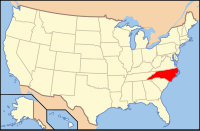Gaston County, North Carolina
| Gaston County, North Carolina | ||
|---|---|---|

Gaston County Courthouse in Gastonia
|
||
|
||
 Location in the U.S. state of North Carolina |
||
 North Carolina's location in the U.S. |
||
| Founded | December 21, 1846 | |
| Named for | William Gaston | |
| Seat | Gastonia | |
| Largest city | Gastonia | |
| Area | ||
| • Total | 364 sq mi (943 km2) | |
| • Land | 356 sq mi (922 km2) | |
| • Water | 8.1 sq mi (21 km2), 2.2% | |
| Population | ||
| • (2010) | 206,086 | |
| • Density | 579/sq mi (224/km²) | |
| Congressional district | 10th | |
| Time zone | Eastern: UTC-5/-4 | |
| Website | www |
|
Gaston County is a county in the U.S. state of North Carolina. As of the 2010 census, the population was 206,086. The county seat is Gastonia.Dallas served as the original county seat from 1846 until 1911.
Gaston County is included in the Charlotte-Concord-Gastonia, NC-SC Metropolitan Statistical Area. It is the third largest county in the metropolitan area, behind Mecklenburg County and York County, SC. It is located in the southern Piedmont region.
Of North Carolina's one hundred counties, Gaston County ranks 74th in size, consisting of approximately 364.5 square miles (944 km2), and is seventh in population. The county has fifteen incorporated towns.
The earliest European settlers of Gaston County were principally Scots Irish, Pennsylvania Dutch, and English. In the 1750s, Dutch settler James Kuykendall and others constructed the Fort at the Point at the junction of the Catawba and South Fork Rivers. The fort was built because of ongoing hostilities with the Cherokee, but it was apparently never attacked. Tensions between the settlers and the Native American inhabitants (primarily of the Catawba tribe) were eased considerably when the boundary dispute between North Carolina and South Carolina was settled in 1772, after which most of the Catawba settled on a reservation near Fort Mill, South Carolina.
...
Wikipedia

